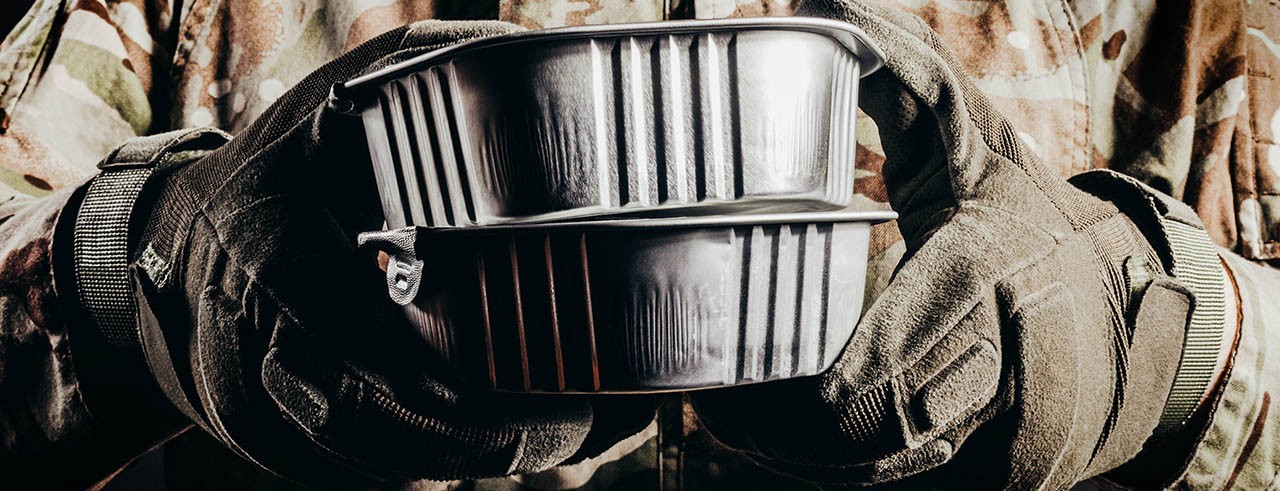
How a UC technology transformed the marketplace for ready-to-eat meals
Compact, flameless heater allows for pre-packaged hot dinners
Whether it's chili with beans, barbecued beef or meatballs in marinara sauce, members of the United States military are served up a rotating menu of entrees through meals, ready to eat rations.
Packed in individual pouches, these self-contained meals can be eaten during combat operations, humanitarian missions or field trainings, providing nourishment on the go.
Yet while MREs were first piloted for U.S. military members during the Vietnam War, it wasn't until the 1990s that it's been possible for these meals to be served hot.
We can thank a former University of Cincinnati researcher for that.
Safe cooking in the field
While employed at UC as a professor of mechanical engineering, William Kuhn, PhD, had an idea for a compact, flameless heater that could be enclosed in a pre-packaged meal to safely warm it.
With funding from the U.S. Navy, Kuhn developed the Flameless Ration Heater using a water-activated electrochemical pad composed of magnesium-iron alloy dispersed in plastic powders. Enclosed in a cardboard cover, the heater pad was sealed in a high-density, polyethylene bag with pre-printed instructions. The packaging system protected the heating device and served as a heater bag for the entree.
Kuhn's testing revealed that the heater could warm an entree from 40 degrees F to 140 degrees F in 12 minutes or less with no risk of starting a fire. Plus, the system could operate in ambient temperatures from -25 degrees F to 110 degrees F, with only two ounces of water for activation.
First used during the Persian Gulf War by the U.S. Army, the lightweight, cost-effective system transformed the meals, ready to eat landscape and generated national media coverage, with CNN and The Today Show touting the innovation during newscasts.
Expanding the market
"The military was the first customer, and then Kuhn and his collaborators launched a consumer product," said Geoffrey Pinski, assistant vice president for technology transfer in the 1819 Innovation Hub.
After test marketing, Kuhn and team began offering a commercial option in 1995 called HeaterMeals.
Initially targeting laborers and truck drivers who wanted a hot meal to go, the company expanded its market over time to outdoor enthusiasts and other consumers wanting a quick meal option. Early research, in fact, showed that roughly a quarter of purchasers ate HeaterMeals in the kitchens of their own homes.
The meals, which are still marketed commercially today, offer a variety of entrees, heater, seasonings and activator solution. They need no refrigeration and have an extensive shelf life.
Simplifying the process
It’s the job of the 1819 Innovation Hub, created in 2018 as the centerpiece of the Cincinnati Innovation District, to get great ideas like this out of the lab and into the marketplace.
Technology transfer means taking your intellectual property from creative idea to commercial application. The 1819 Innovation Hub’s tech transfer team offers innovators the resources and expertise they need to license, patent and develop their ideas. By attracting outside sponsors and securing patents and rights, the team helps inventors to advance knowledge and make a positive impact on society.
“Our mission in technology transfer is to help research make an impact through commercialization,” Pinski said.
Featured image at top: Shutterstock photo.
Learn more about UC's Tech Transfer process
The 1819 Innovation Hub’s technology transfer team facilitates the transfer of inventions from academic research labs to market. Find out more at Inventor's Guide to Technology Transfer at the University of Cincinnati and Take your NEXT step.
Related Stories
‘Empowered to drive innovation’
November 22, 2022
For the second year, four students from the University of Cincinnati have been named University Innovation Fellows (UIF), a program run by Stanford University’s Hasso Plattner Institute of Design.
How a UC technology transformed the marketplace for ready-to-eat meals
September 19, 2023
While employed at the University of Cincinnati as a professor of mechanical engineering, William Kuhn, PhD, had an idea for a compact, flameless heater that could be enclosed in pre-packaged meals to safely cook them. The device transformed the meals, ready to eat landscape through a simple process involving salt water and a magnesium-iron alloy.
P&G, UC celebrate partnership that accelerates innovation
March 22, 2023
As UC and P&G build on their partnership, they have renamed and celebrated the P&G Digital Accelerator @ The University of Cincinnati.